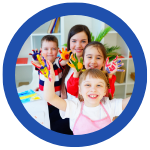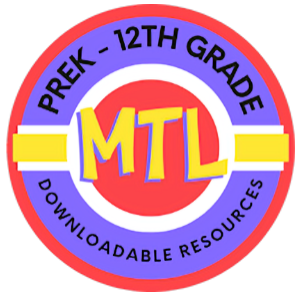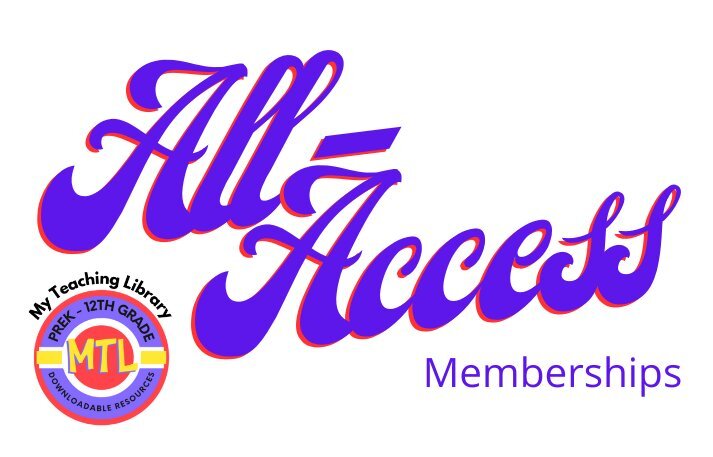Skills & Concepts for Kindergarten

Below is a list of Skills and Concepts for Kindergarten PLUS links to resources you can use to teach and reinforce these skills/concepts!
These resources are not the only products available for Kindergarten. To view all Kindergarten resources, go to our Educational Library.
You can purchase each resource individually or if you are an All-Access member, every resource is included in the cost of your membership!
That means, you can download every resource listed below at no additional cost. Your membership covers it!!
English/Reading/Writing
- – Develop handwriting skills: letter formation / Writes uppercase and lowercase letters
- – Learns all of the letters of the alphabet (upper case and lower case) and their sounds.
- – Recognizes several basic sight words such as I, my, you, is and are.
- – Begins to “read” books himself, mainly from memorization.
- – Reads and listens to stories and then talks about stories, their plots, characters and events.
- – Follows words from left to right, top to bottom, and page by page.
- – Recognizes and can produce rhyming words.
- – Adds or substitutes individual sounds in simple, one-syllable words to make new words. For example, replaces the “C” in “Cat” with an “R” to create the word “Rat.”
- – Writes his/her name.
- – Writes some letters and words when they are dictated.
- – Uses invented or creative spelling to write a variety of words. / – Writes, Draws and Dictates about a variety of topics, including his opinion, a description of something or a moment or event in his life.
- – Uses conventional spelling to write some words (CVC and basic sight words).
- – Use a variety of strategies to decode and comprehend text
- – Use picture clues to comprehend text
- – Apply phonics skills
- – Acquire and apply new vocabulary
- – Practice writing literacy elements daily: consonants to correspond to sounds.
- – Develop oral language: answer questions; share information
- – Interpret and evaluate materials read to them
Recommended English/Reading/Writing Sample Activities
- Read and Repeat: Have your child “read” her favorite book to you, using her memory, associations and clues from the pictures.
- Alphabet Books: Use drawings or pictures from magazines to create an alphabet book which has a letter and an object that begins with that letter on each page.
- Fill in the Blank: When you read a favorite picture book to your child and you come across a short word that rhymes or is familiar to your child because he knows the book very well, stop and let him say the word. Point to the word as he says it and spell it out.
- Act it Out: Act out parts of or the whole story of your child’s favorite and well-known books.
- Label Things: Create labels with your child for different objects in your house. For example, different books, places for toys, foods or objects in the kitchen, or clothes. You or your child can write the names of the objects and your child can draw a picture to go along with it.
- Guessing Games: Draw a picture and have your child guess the spelling of that word. Give your child a few letters in a word. For example, show your child “_AT,” and ask him to make as many words as he can with it.
- Create a Photo Album: When you take pictures of events or people ask your child to label the picture. Glue the picture to a piece of a paper so your child can write a description of the event, what happened, who was there, etc. If other people were involved in the event send them a copy!
- Have a Letter Treasure Hunt: When you are in the car, at home or in the store, ask your child to find certain uppercase and lower case letters. She can keep a list of all the letters she finds and she can write them down as she finds them.
Math
- – Understands that numbers represent quantity and uses them to do so.
- – Counts and writes numbers, from 1-20 (and potentially higher).
- – Counts out and compare quantities, usually up to 20.
- – Counts out and groups objects in order to solve single-digit addition and subtraction problems.
- – Begins to recognize and understand the meaning of the plus and minus signs.
- – Uses drawings, objects, actions and sounds to represent and practice addition and subtraction.
- – Practices beginning measurement and graphing skills, often through the creation of class-wide graphs, such as graphing favorite snacks, or how kids get to school.
- – Learns about and begin to count to 100, specifically through a tallying of the days of school and a celebration on the 100th day of school. (Many but not all kindergarten classes do something like this).
- – Creates patterns.
- NUMBER SENSE & OPERATIONS
- – Model, count, read, write, and compare cardinal numbers to 100.
- – Estimate quantities
- – Create and model simple addition (sums to 10) and subtraction stories using concrete objects and drawings.
- – Model and demonstrate an understanding of the concept of whole and half
- – Matching quantities to numbers
- PATTERNS, RELATIONS & ALGEBRA
- – Reproduce, describe, extend, and create patterns.
- – Count by 5’s and 10’s to at least 50.
- – Sort and classify objects by color, shape, and size; identify attributes.
- GEOMETRY
- – Identify positions of objects in space (e.g. next to – above – below – on top)
- – Name, describe, sort, & draw squares, circles, triangles & rectangles; describe attributes.
- – Name and compare 3-dimensional shapes.
- MEASUREMENT
- – Use non-standard units and appropriate language to recognize, measure, and compare length, weight, area, and capacity.
- – Demonstrate a beginning understanding of the concept of time (e.g. duration)
- – Identify coins (pennies, nickels, dimes, quarter)
- DATA ANALYSIS, PROBABILITY, & STATISTICS
- – Collect and organize data in lists, simple graphs, and tally charts.
- – Demonstrate a beginning understanding of the concept of chance (e.g. heads/tails, spinner parts)
Suggested products to master the above Math skills
Recommended Workbooks:
- Kindergarten Math Workbook #1
- Kindergarten Math Workbook #2
- Kindergarten Math Workbook BUNDLE
- Kindergarten Language Arts – Math – Science Workbook
Additional recommended products to master skills:
- Numbers 1-20 | Kindergarten Posters – Centers – Worksheets
- Math Counters and Ten Frames | Butterfly Themed
- Numbers and Number Words 1 to120 | Butterfly Themed Cards
- Math Visuals – Manipulatives Bundle | Butterfly Themed
- Math Posters | Numbers 0 to 10
- Numbers 1-10 | Marbles in a Jar Centers and Worksheets
- Ten Frame Sets | 5 Complete Sets
- Numbers 1 to 10 | Marbles in a Jar Centers and Worksheets
- Numbers Lapbook 1-10
- Trace, Color and Count Numbers | Shapes
- Tracing Numbers 1-120
Fun holiday and seasonal products:
- Christmas Math for Kindergarten
- Christmas Bundle for Kindergarten
- Kindergarten Christmas Activities – Numbers, Letters, Colors
- New Year’s Math Center Activities | Kindergarten | 1st Grade
- Mitten Themed Literacy, Math and Science Winter Activities
- February Math for PreK to Kindergarten | Valentine Themed
- March Math for Kindergarten
- March Math Center Materials
- Kindergarten Summer Skills Review Packet
- Christmas Math 1-100 | Worksheets and Activities
- Peppermint Candy Numbers and Number Words
Sample Activities
- Cook with Patterns: Patterns can be used in lots of cooking. Make patterns with cereal necklaces, decorate cookies, make layered sandwiches with bread or crackers or make simple patterns using your child’s favorite colored candies.
- Tell Math Stories: Use objects or even yourselves to practice addition and subtraction. If you have a bowl of 5 apples, ask your child to help figure out how many you will have left if you take away 3.
- Build Things: Use blocks, Legos or any other building toys to construct houses, towers, vehicles etc. As your child builds, ask him to count pieces, create patterns, and talk about the shapes.
- Take a Poll: Ask family members a question and create a graph of the answers using numbers and pictures.
- Find the Sizes in Nature: Go outside and collect things in nature such as leaves, stones and pinecones. After you’ve collected things, count how many things you found and then talk about their sizes, which are larger, smaller and the largest and smallest. You can even add together objects that are the same (for example, all of the leaves).
Science
Makes observations and records what is seen and learned using graphs, pictures and words..
EARTH SCIENCE:
-
- – Know that the sun supplies heat and light to the earth.
- – Observe, describe, and compare objects in the daytime and nighttime skies; describe full, half, and crescent moons.
- – Identify the seasons of the year and day/night as repeating patterns.
Sun, Earth and Moon | Science for Early Learners
The Four Seasons | Science Mini-Book
LIFE SCIENCE:
-
- – Classify things as living or nonliving.
- – Identify what plants and animals need to survive; identify animals in their natural habitats and determine how basic needs are met.
- – Understand that plants and animals go through predictable life cycles; describe changes in appearance over time.
Living vs. Nonliving Minibook
Living vs Nonliving Classification Cards
Animal Habitat Flannel Board Set
Animal Habitat Flannel Board Set
Life Cycle of a Hedgehog | Early Learning
Life Cycle of a Butterfly | Science Student Created Book
Life Cycle of a Flower| Science Student Created Book
Life Cycle of a Frog | Science Student Created Book
Life Cycle of a Ladybug | Science Learning for Young Students
PHYSICAL SCIENCE:
-
- – Sort and classify objects using the senses; compare color, size, shape, weight, texture, temperature, material, and flexibility of objects.
- – Compare properties of different amounts of the same kind of matter; conclude that amount does not change properties.
Shape Sorting
Big or Small Worksheets
Classification | Which does not belong?
Learning to Classify | 300 Real Picture Cards – 36 Categories
ENGINEERING/TECHNOLOGY
-
- – Describe ways objects move (e.g. straight line, zigzag, back-forth, fast, slow).
- – Identify and describe the safe and proper use of tools and materials; describe how animals use parts of their bodies as tools.
Learning about Patterns of Movement
How Animals Use Their Body Parts | Notebooking Unit Study
How Animals Use Their Body Parts Mini-Book
Sample Activities
- Observe Nature: Pick something in nature — plants, the moon a rain storm, etc. — and observe it with your child for a few days or even weeks. Ask your child to draw pictures of what she notices, patterns and differences between things. You can write things down as well. Do this repeatedly and keep a science journal of different objects.
- Inspect Your Food: Cut open different fruits and vegetables and see what you find inside! Talk about the seeds, the difference between fruits and vegetables and other things you notice. Try planting some of the seeds!
- Make Science Collages: Use pictures from magazines, newspapers or online (with supervision) to create collages of different categories of science objects, such as animals, plants birds and fish.
- Learn About a Favorite Animal: Pick an animal your child loves and learn about it. Read about it, see it at a zoo or farm or look at pictures online. Then help your child create a collage of she what she learned about that animal using pictures and texts.
Social Studies
- – Works in groups, sharing and taking turns.
- – Develops conflict resolution skills.
- – Develops communication and conversation skills.
- – Learns about his community, outside of his home.
Community Helper Flash Cards
Community Helpers – Volume 1
Community Helpers – Volume 2
Community Helpers – Volume 3
- – Learns about the calendar.
Months of the Year Word Wall
Calendar Bulletin Board Materials | Tiger Themed
Calendar Bulletin Board Materials | Bear Themed
Calendar Bulletin Board Materials | Turtle Themed
Calendar Bulletin Board Materials | Frog Themed
- – Learns about national holidays.
Presidents Day Learning for Early Learners
Presidents Flip Books | Washington and Lincoln
George Washington Puzzles
Christopher Columbus | Poem Copy Work
Christopher Columbus | Preschool – Kindergarten Unit
Memorial Day Unit | Kindergarten – 1st Grade
- – Discuss, identify and use vocabulary related to time and order
Days of the Week | Word Cards
- – Discuss and apply vocabulary related to location and direction
Home Geography for Primary Grades(Great to begin in Kindergarten and use for the first couple years!)
- – Discuss and identify the general meaning of some national symbols
- – Discuss the connection between work and money
Other great Social Studies/History additions for Kindergarten:
All about My Family | Celebration Activities
All About Me Learning Center Activity
My Memory Book
All About Me – Student Created Mini-Book
Write Your Address Worksheet
US Presidents Notebooking and Mini-Books | BUNDLE
Central America Country Studies BUNDLE | K-2nd
South America Country Studies BUNDLE | K-2nd
Sample Activities
- Study Your Community: Walk around your local neighborhood and take pictures of, draw pictures of and help your child write about what she notices. Encourage your child to talk to different people in the community and ask them questions. Then make a poster or short book about your town. Your child can then send this info to a friend or family member who lives somewhere else.
- Take a trip: Compare your own town and community to ones around you. If you live in a city, visit a more rural or suburban area. If you live in a rural area or suburb, visit a city. Talk about the differences and similarities or make a chart of them.
- Act it Out: Use role play to help your child work on his conflict resolution skills. Act out small situations of conflict such as: what happens if someone is playing with a toy you want or what happens if you don’t agree with someone about something. Help your child figure out specific strategies he can use in different situations.
- Make a Group Plan: Work with other family members or friends on a specific task such as cleaning up a yard or room, or cooking or setting up a meal or party. Assign everyone specific roles and figure out how to work together in the best way possible.


